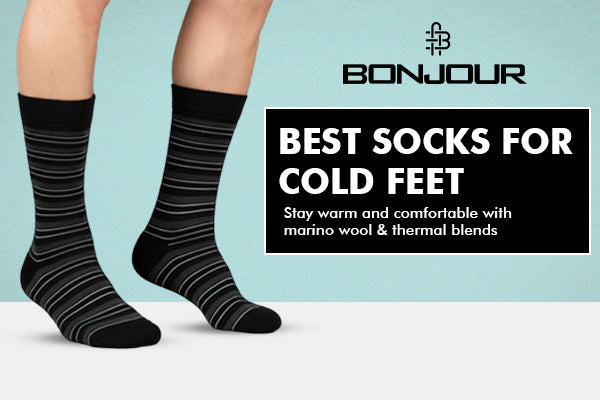
What Are the Best Socks for Cold Feet?
Cold feet can make winter mornings and long days unbearable. Many people wonder, “What are the best socks for cold feet?” The right pair of socks can keep your toes warm, dry, and comfortable, whether you’re working, traveling, or relaxing at home. In this guide, we’ll explore the features, materials, and styles that make socks perfect for cold feet, along with practical tips for care and maintenance.

Why Feet Get Cold
Feet are often the first part of your body to feel the chill because they are far from the body’s core, which slows blood circulation. The skin on your feet is thinner, and there are fewer muscles for natural insulation. Tight shoes or damp footwear worsen the problem, leaving your feet cold and uncomfortable. Understanding these factors helps you select the best socks for cold feet, ensuring warmth and comfort during winter months.
Key Features of the Best Socks for Cold Feet
When looking for the best socks for cold feet, focus on several important features. A warm sock should trap heat while allowing moisture to escape to prevent cold, damp toes. Soft, high-quality fabric prevents irritation, and durable construction ensures that socks retain their shape and insulation over time. Socks designed for cold feet often combine natural materials like wool with synthetic fibers for added stretch, durability, and thermal efficiency.
Best Materials for Cold Feet
The material of a sock is critical for warmth. Merino wool is one of the best options for cold feet. It provides excellent insulation even when slightly damp and naturally wicks away moisture to keep your toes dry. Merino wool is also soft, avoiding the itchiness of traditional wool. Thermal blends, often made with wool combined with polyester, acrylic, or spandex, offer added stretch and lightweight warmth. Bamboo socks are soft and breathable, though less insulating than wool. Cotton socks are not recommended for extremely cold conditions because they retain moisture and can leave feet cold.
Sock Styles That Keep Feet Warm
The style of your socks affects warmth just as much as the material. Crew-length socks cover the ankle and part of the calf, making them ideal for boots or layering. Thermal socks are thicker and cushioned for extreme cold, while compression socks improve circulation to help maintain warmth. Toe socks reduce friction and prevent blisters, ensuring even warmth across all toes. Choosing the right style for your needs ensures the best results.
Matching Socks to Activities
Different activities call for different sock types. For work, slim merino wool crew socks provide warmth without bulk. Outdoor adventures such as hiking or skiing benefit from heavy thermal wool or wool-blend socks for superior insulation. Travelers or those sitting for long periods may prefer compression wool socks to prevent swelling and maintain warmth. At home, cozy bed socks with gentle grip provide comfort for lounging or sleeping.
Tips to Maximize Warmth
To get the most from your socks, proper fit is crucial. Socks that are too tight restrict circulation and make feet colder, while socks that are too loose can bunch up, reducing insulation. Layering a thin liner under a thicker wool sock can provide additional warmth without bulk. Padding around the heel and toes increases comfort and prevents cold spots. Reinforced fabric ensures durability and long-lasting warmth. Even warm socks need breathability to prevent sweat accumulation and odor.
Caring for Socks to Maintain Warmth
Proper care extends the life and performance of your socks. Wash them in cool water to preserve fiber elasticity and avoid shrinkage. Air-drying prevents damage from high heat, while storing socks flat helps maintain shape and structure. Well-cared-for socks provide lasting warmth and comfort throughout the winter season.
Expert Recommendations
Some of the most highly recommended socks for cold feet include merino wool blends and thermal fabrics. Heat Holders® Thermal Socks are engineered for maximum insulation in extreme cold. Darn Tough Midweight Socks are durable and perfect for outdoor activities. Smartwool Everyday Crew socks are thermoregulating, offering comfort and warmth for daily wear. These options combine insulation, durability, and softness, making them excellent choices for anyone seeking the best socks for cold feet.

FAQ: Best Socks for Cold Feet
Q: Can cotton socks keep my feet warm in winter?
A: Cotton is not ideal for cold feet because it retains moisture and dries slowly, which can leave your feet cold and damp.
Q: Are wool socks itchy?
A: Traditional wool can be itchy, but merino wool is soft, breathable, and comfortable for all-day wear.
Q: How should I layer socks for extreme cold?
A: A thin moisture-wicking liner sock under a thick wool or thermal sock provides maximum warmth without bulk.
Q: Do compression socks help with cold feet?
A: Yes, compression socks improve circulation, helping to maintain warmth during long periods of inactivity or travel.
Final Thoughts
The best socks for cold feet are those that combine warmth, breathability, comfort, and durability. Merino wool and thermal-blend socks provide excellent insulation and moisture control, while proper fit and smart layering maximize warmth. By caring for your socks and choosing the right materials and styles for your activities, you can enjoy cozy, comfortable feet all winter long. Investing in quality socks ensures that cold toes no longer disrupt your day, whether at work, outdoors, or relaxing at home.






